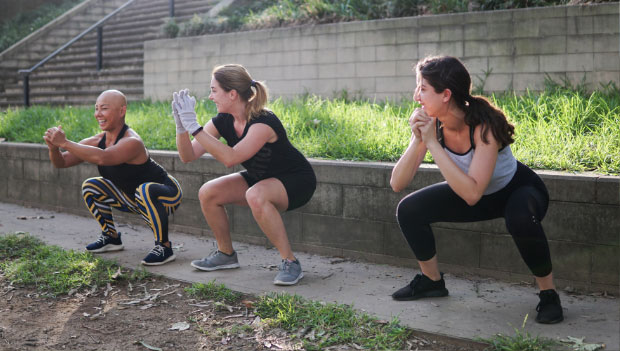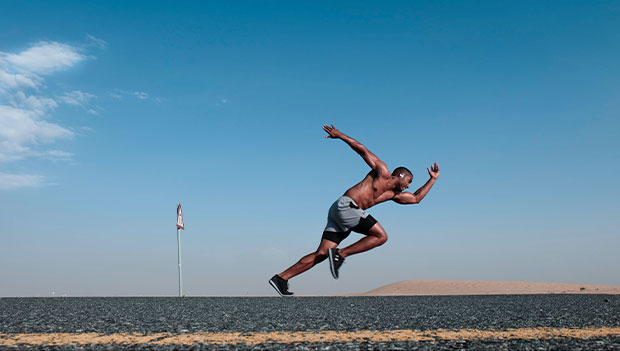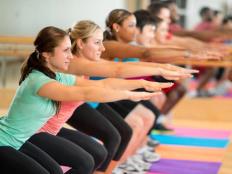
Aerobic Exercise | Cardio Workouts | Best Jump Ropes | Best Compact Cardio Equipment | Best Cardio Machines | 30-Day Cardio Challenge
Let's play a game of word association!
Cardio.
I bet you thought of running. You did, didn't you?
Next word; treadmill.
This is a little tougher, but I'm guessing the words "dread" and "boring" came to mind.
The majority of us associate cardio workouts with running. And, while running certainly has a host of incredible benefits, if all you're doing to get your cardio sessions in is hitting the pavement or the treadmill, boredom may set in. Boring workouts lead to skipped workouts.
Although we're not suggesting that you hang up your running sneakers, we are going to break down how to incorporate some other cardio workouts into your routine to keep it fresh and exciting.
Benefits of Cardio Exercise
The list of benefits for regular cardio workouts is as varied as it is long.
According to the Mayo Clinic, regular cardio workouts:
- Help you lose weight and keep it off
- Strengthen your heart
- Increase stamina and lower fatigue
- Make you less susceptible to viral illnesses such as the cold and flu
- Lower blood pressure
- Control blood sugar
- Lessen your chances of diabetes, heart disease, and some cancers
- Give you better mobility as you age
Cardio Workout Techniques
Gone are the days of trudging on a treadmill or running loops around your neighborhood to get your heart pumping—nowadays there are a variety of techniques that you can implement to throw a little seasoning on your workout.
HIIT (High-Intensity Interval Training)

The popularity of high-intensity interval training (HIIT) has skyrocketed in the past few years. HIIT is especially good for cardio junkies who want to avoid the monotony of the steady rhythm of jogging or cycling. This is because the very nature of HIIT is to give intense efforts in short spurts followed by quick recovery times.
The programming usually consists of several movements that are performed over multiple rounds. The movements in HIIT often only require body weight or limited equipment. This makes getting in a HIIT routine easy no matter if you're at home, the gym, or even traveling. These exercises challenge your heart, lungs, and various muscle groups. They also help you work up a heckuva sweat. It is important to follow the protocol, which often means going hard during the working portions, because the key to getting the most out of HIIT is the intensity. This technique is designed so that you can recover enough during the rest periods to go all out when you are working.
HIIT Highlights
- Fun and fast-paced
- Can be done almost anywhere
- Efficient use of time
AMRAP (As Many Rounds as Possible)
AMRAP and HIIT are definitely related in that they are both based on doing an intense amount of work in a set amount of time, but like that slightly wild cousin, an AMRAP is non-stop. Unlike, HIIT, AMRAP doesn't have built-in rest. When utilizing the AMRAP technique, you complete as many rounds of the prescribed exercises in a set amount of time as you're able to do.
Given the speed and intensity in which AMRAPs are conducted, you should determine the type of exercises that you want to do as well as the number of reps you'll perform for each exercise. AMRAPs can be performed with bodyweight exercises such as squats, push-ups, and burpees, or, if you have the equipment, you can do movements such as pull-ups and box jumps or pick a certain distance or amount of calories to achieve on an indoor rowing erg or stationary bike.
AMRAP Highlights
- Easy to get a full-body workout
- You control the length of your workouts
- Able to mix in a lot of variety
Steady State
OK, OK, we've discussed the hare techniques—those that are speedy and maybe even a little sexy—yet how quickly we forget that the tortoise actually ended up winning the race. Now this isn't to say that the Steady State technique is the winner (because we're all winners here), but there is something to be said for the benefits of lower-intensity cardio workouts that are done for a longer period of time.
The Steady State technique helps build endurance because it trains our bodies to operate efficiently for a longer period of time. When implementing this technique, you get your heart rate to a moderate level (generally 135-140 beats per minute) and maintain that over a longer duration of time.
Steady State Highlights
- Builds endurance
- Can be performed daily
- Makes the heart perform better during long physical activity
Now that we've discussed the benefits of cardio exercises and the various techniques that we can use, it's time to break down some exercises that will get the heart pumping and the sweat dripping.
The OG Cardio Contingent
Walking/Jogging/Running
Sometimes there is nothing better than lacing up your sneakers and simply putting one foot in front of the other at a speed of your choosing. Grab a pair of sunglasses, take it outside, and enjoy the fresh air!
Cycling
Perhaps it's nostalgia from the days of peddling around the neighborhood with our childhood friends or maybe it's because it is something we never forget, but cycling, be it indoors or in the great wide open, is fun, challenging, and beneficial.
Swimming
Chlorine is one of my favorite smells, and although swimming is a physically taxing activity, it never seems that bad—maybe it's because my olfactory receptors are so happy. Swimming is also great because it provides an intense workout without much stress on your body.
No Excuses Bodyweight Movements
Squats

With your feet about shoulder-width apart, initiate the movement by pushing your butt back like you're closing a car door. Then bend your knees until your hips are below the crease in your knee (or as far as is comfortable for you). Once you are at depth, drive your heels into the ground while tightening your butt and core as you stand up straight.
Burpees
Start off standing with your feet under your shoulders and your arms hanging by your sides. Bend your knees into a squat position and lower your hands to the floor. Kick your legs back so your hands and toes are on the ground and your elbows are bent in a push-up position. From there, push up with your arms and jump your legs forward to hop back up to standing. Finally, jump up and reach your hands over your head, landing with your knees slightly bent.
Plank Jacks
Begin this exercise by lying on your stomach and pushing into the plank position (arms extended so that your chest and legs are off the ground). Engage your core and keep your butt tight, then jump your feet out to the side like you would in a jumping jack.
With the Right Equipment
Rowing
A rower is an effective and low-impact way to get in a sweat session. You can challenge yourself with short sprints or sustained paces. Many rowers now come with built-in programming and on-demand videos with certified instructors who will take you through the paces.
Jumping Rope
Jumping rope is one of the most effective ways to challenge yourself cardiovascularly. It is a simple and fairly inexpensive piece of equipment that can provide you with great benefits. You can spice up your experience by learning to do double-unders (the rope travels under your feet twice during one jump) or trying single-leg jumps.
Box Jumps
If you have a plyometric box (or a sturdy, stable elevated item that you can safely jump on), box jumps are a great and fun way to add some variety to your cardio workouts. You can simply jump onto the box, stand, and jump back down, or you can jump onto the box from one side and step down on the other. If you want to up the intensity even more, give a burpee and then a box jump a whirl.
It's Time for Action
So, how do we put these techniques into practice and movements into use in helping us meet our specific goals? Let's take a look at some of the common goals that people have with cardio exercises and go over some tips and pointers as to what will help you the most.
Cardio Exercises for Weight Loss

If you want to shred some pounds, here are some the best movements to help you reach your goal weight:
- Sprinting: When it comes to quickly burning calories, sprinting is king. However, since sprinting is not designed to be done for long distances or times, try sprinting a half lap and then jogging a whole lap. Eventually, you can up the distance to a full lap each. If there are stairs or bleachers handy, you can blaze to the top and then use coming down as a recovery.
- Jumping rope: There are several reasons that we've all seen Rocky Balboa (and other real-life boxers) furiously jumping rope in preparation for their next big fight. Not only is it great for improving coordination and increasing speed, it also burns a crazy amount of calories. Also, jump ropes are an inexpensive and portable way to get a workout in at the gym, at home, or even in a hotel room.
- HIIT: The intense output that is required for HIIT workouts makes it an ideal way to shred some pounds. Additionally, HIIT workouts often incorporate pure cardio movements, bodyweight exercises, and even some weight training. This is a perfect recipe to burn a ton of calories, but remember, you must only rest for short periods of time to make this effective.
Cardio Exercises for Better Athleticism
Look at the workouts of college and professional athletes for the type of exercises that you need to do to increase your athleticism. In addition to weight training and running, athletes perform drills like the following to help them improve their overall athletic prowess.
- Sled push: There are few exercises that utilize full-body strength, speed, and power like that of the sled push. It not only slays calories, but by engaging so many of your muscle groups, it makes you more explosive, which leads to you becoming speedier.
- Kettlebell swings: If you want to get your whole body involved in an exercise movement, grab a kettlebell and start swinging (just make sure no one is in front of you). Kettlebell swings can help your athleticism because they are both cardiovascular and they fire up your posterior chain, which includes your glutes, hamstrings, and some of the muscles of your lower back. A stronger posterior chain improves both your explosiveness and overall power.
- Jump squats: Jump squats are a variation of a traditional squat that includes a—you guessed it—jump. Jump squats are particularly good at improving your vertical leap and making you more explosive. Additionally, jump squats improve your balance and overall coordination because they help train your body to land on your feet without the assistance of your hands.
Cardio Exercises for Building Muscle
Although cardio-intensive exercises mainly concentrate on improving your heart and lung capacity, don't forget that they can help build other muscles, as well. Here are some of our favorites for pumping you up.
- Walking lunges: Blending strength with cardio, walking lunges are a surefire way to help you sculpt some of your lower-body glory muscles such as the glutes and hammies. Walking lunges have the added benefit of building up the musculature around your knees which helps prevent common injuries.
- Goblet squats: Goblet squats are a weighted variation of squats. These are performed by holding a dumbbell or kettlebell close to your chest and doing squats. This helps build the posterior chain muscles and make you more explosive and powerful.
- Farmer's carries: This exercise is as effective as it is simple. Pick up something heavy such as a couple of kettlebells or a pair of dumbbells and carry them from one place to the next. However, don't let the simplicity fool you, this exercise builds a rock-hard core and strengthens your grip. It also pumps up most of the muscles in your arms and shoulders, while simultaneously engaging your upper back and obliques.
Cardio has garnered an unfortunate reputation as being boring and monotonous, but it is truly anything but dull. By implementing the various techniques such as HIIT and AMRAP, or a guided fitness program with these tried-and-true steady state, you can elevate your cardio workouts into multi-faceted and fun endeavors.
Aerobic Exercise | Cardio Workouts | Best Jump Ropes | Best Compact Cardio Equipment | Best Cardio Machines | 30-Day Cardio Challenge
Get ACTIVE on the Go


Couch to 5K®
The best way to get new runners off the couch and across the finish line of their first 5K.
Available for iOS | Android








Discuss This Article